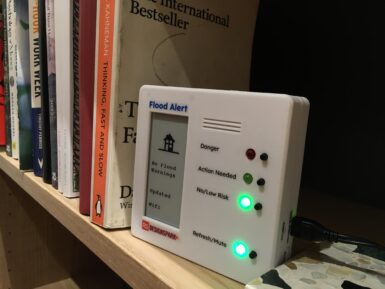
16x2 LCD display with I²C interface
2-line, 16-character alphanumeric LCD display with HD44780 controller, blue backlight, white characters, and I²C interface.
Overview
Particularly suitable for reducing the number of I/Os required when used with Arduino or other microcontroller, the I²C interface has jumpers to activate the backlight and contrast adjustment which is carried out via a small trimmer.
Tech specs
- Power supply: 2.5-6 Vdc
- Dimensions (mm): 80x36x19
- Weight: 100 grams
Conformities
Get Inspired
An IoT Moisture sensor that sends moisture data from an Arduino Nano 33 IoT to the Arduino IoT Cloud

As climate change continues to worsen, events such as heavy rains, hurricanes, and atmospheric rivers have only intensified, and with them, large amounts of flooding that pose serious risks to life and property. Jude Pullen and Pete Milne, therefore, have responded by creating a "physical app" that can show the potential for flood dangers in real-time with sound, lights, and an ePaper display. The Arduino Nano 33 IoT powering the Flood Alert device sources its data from the UK Environmental Agency’s API to get statistics on an area’s latest risk level along with an extended description of what to expect. Initially, the electronics were mounted to a breadboard and housed within a cardboard enclosure, but a later revision moved everything to soldered protoboard, a 3D-printed case, and even added a piezoelectric buzzer to generate audible alerts. For now, the Flood Alert’s sole source of data is the aforementioned API, but Pullen hopes to expand his potential data sources to include “hyper-local” sensors that can all be aggregated and analyzed to give a much more precise view of flooding in a smaller area. To learn more about Flood Alert and its myriad applications to local communities and beyond, check out the original long read article’ is available at DesignSpark.






